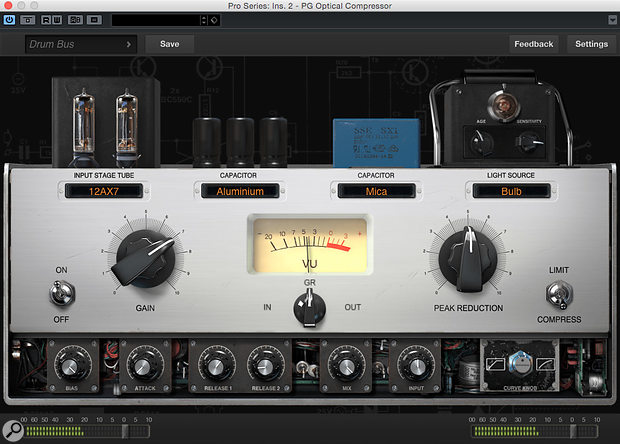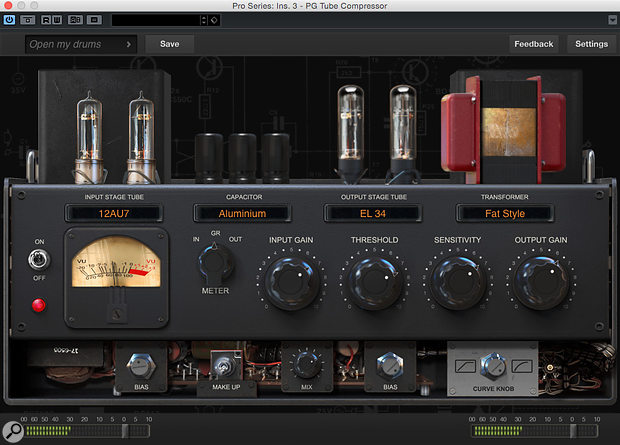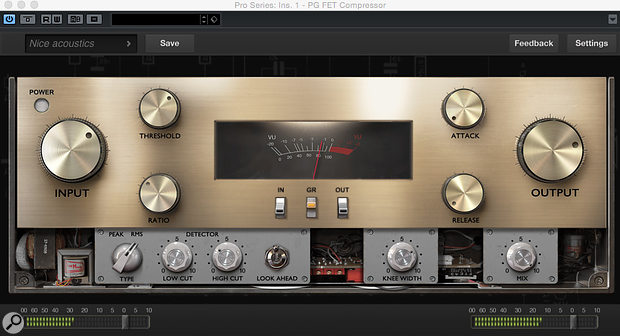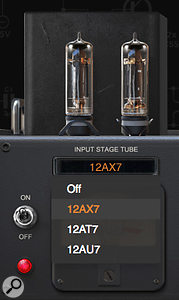 The Pro Series optical compressor: LA-2A-inspired but with the option to swap out virtual components.
The Pro Series optical compressor: LA-2A-inspired but with the option to swap out virtual components.
Positive Grid’s latest plug-ins let you craft your own boutique compressor designs without ever touching a soldering iron.
Alongside equalisation, compression is perhaps the most widely used processing tool within the mixing and mastering processes. It’s hardly surprising, therefore, that it has been discussed many times in the pages of SOS; and back in the September 2009 issue, Mike Senior provided his 'Compression Made Easy' article that forms an excellent ‘Compression 101’ class. As Mike explains, compression has been implemented using a number of different circuit topologies including VCA, vari-mu, optical and FET technology, as well as hybrid designs. Each approach has its own sonic characteristics, and these differences have led experienced mix engineers to prefer specific compressor designs for particular mix tasks.
Of course, we now have the software compressor and, as computer power has advanced, so has the accuracy with which a plug-in compressor can not only control the dynamics of an input signal, but do so in a way that emulates the specific characteristics of classic hardware models. Waves’ CLA Classic Compressors Collection is an obvious example: it includes emulations of the FET-based UREI 1176, which is great for heavy compression on drums, guitars and bass, and the hybrid electro/optical/tube Teletronix LA-2A, which is famed for its silky-smooth sound, but can also be overdriven very effectively. These types of plug-ins can sound very good indeed but, although they’re a lot more affordable than the original hardware, can nevertheless come with a hefty price tag — the aforementioned Waves collection is currently $599.
The other obvious point about software emulations of specific hardware is that, naturally, they tend to share the limitations of the original hardware. That’s not a criticism — it’s those sonic characteristics and design quirks that gave the device its reputation in the first place — but there are times when you might wish for more versatility.
Mix & Match
So, how would it be if, within the overall ethos of something like a tube or FET or optical design, you could build your own compressor? Well, now you can, thanks to Positive Grid’s new Pro Series plug-ins. At a fairly modest introductory price, the first of these provides three distinctive compressor plug-ins, emulating tube, optical and FET circuits with options for swapping in and out individual components, so that you can create as many different variations as you like.
 The tube-based compressor offers plenty of character and, with two tube stages, it’s easy to add some overdrive.
The tube-based compressor offers plenty of character and, with two tube stages, it’s easy to add some overdrive.
Positive Grid have implemented similar component-level modelling in their BIAS Amp package, reviewed in the January 2015 issue. Initially launched for iOS but then ported to the desktop, this distinguished itself from the guitar rig software crowd by providing guitar players with a virtual workshop within which they could build their own guitar amp design. You can pick your choice of tubes, preamp block, tone stack, transformer, and any number of other elements, to create the amp of your dreams. And very good it is too.
While component-level modelling itself is not unique, the way Positive Grid presented it to the user in BIAS Amp took it to a new level of accessibility. Having established the principles, they are now bringing the same approach to other studio equipment, and the expectation is that this release will be the first of many. As shown in the various screenshots, the three separate plug-ins look different, and those with a hardware background might detect some visual hints towards the original inspirations; for example, the optical model borrows some of its visuals from the Teletronix LA-2A.
Installation follows a fairly painless download/serial number combination and, with VST, AU, RTAS and AAX formats all supported, compatibility across major DAWs and OS variants should be broad. I did most of my testing with Cubase Pro 8.5 and experienced no particular issues. In terms of workload, enabling a single instance of each model added a modest couple of percent to the average CPU load within Cubase on my test system. Understandably, this is more noticeable than, for example, the standard dynamics processors bundled with Cubase, and perhaps just a little more than that generated by the similarly priced Waves VComp, for example. You might not want to use the Pro Series compressors on every track but, unless CPU cycles are very constrained, multiple instances on selected tracks ought to be possible.
Open Ended
At one level, the Pro Series compressors are fairly standard, if ‘boutique’, compressor emulations; you get an appropriate set of front-panel controls for each of the different models, and vintage-style VU meters that can be toggled between displaying input, gain-reduction or output levels. The FET model presents the most comprehensive control set, with input, threshold, ratio, attack, release and output levels. The front-panel controls of the optical and tube models are simpler — there’s nothing labelled ‘ratio’, for example — just like those of their hardware inspirations.
 For a more transparent sound, and a fuller front-panel control set, the FET model is the choice.
For a more transparent sound, and a fuller front-panel control set, the FET model is the choice.
All three, however, offer additional control options ‘inside the case’. These are options that, in the original hardware, would have involved screwdrivers, soldering irons and a risk of electrocution to change. This component-level editing is most obvious within the tube and optical models, each of which offers four components that you can swap in and out based upon a number of selections. The FET model is less customisable in this regard, but all three plug-ins also have a series of additional controls positioned along the base of the virtual faceplate, representing further tweaks the user could make to the internal circuitry. These include wet/dry options if you want to blend uncompressed and compressed signals for parallel processing, while the FET model includes low and high cut options, which, I think, allow you to EQ the side-chain signal so that compression is triggered by a specific frequency band.
 An obvious way to alter the character of the processing is by swapping out tube types in the tube compressor model.I say ‘I think’ because, aside from the fairly general description on Positive Grid’s web site, the plug-ins are not supplied with any supplementary documentation. At one level I can understand this: installation is easy and the process of adjusting the control set requires no explanation. However, at another level, the studio geek in me wanted an introduction to the three models, a commentary on why there are different, a background to the component modelling process and, most importantly, to be given some guidance (in the absence of knowing anything about the insides of a real hardware compressor) as to why I might, for example, choose a mica capacitor as opposed to a ceramic one. A basic PDF reference manual would not go amiss.
An obvious way to alter the character of the processing is by swapping out tube types in the tube compressor model.I say ‘I think’ because, aside from the fairly general description on Positive Grid’s web site, the plug-ins are not supplied with any supplementary documentation. At one level I can understand this: installation is easy and the process of adjusting the control set requires no explanation. However, at another level, the studio geek in me wanted an introduction to the three models, a commentary on why there are different, a background to the component modelling process and, most importantly, to be given some guidance (in the absence of knowing anything about the insides of a real hardware compressor) as to why I might, for example, choose a mica capacitor as opposed to a ceramic one. A basic PDF reference manual would not go amiss.
Get Stuck In
I started my exploration with the optical compressor emulation, and I nearly didn’t get much further, because I have to say I got totally hooked in exploring just what this plug-in could do with a variety of different sources. I was almost universally impressed. Yes, you can turn a drum track into something lifeless if you’re careless but, equally, you can also go from punch to pump very easily depending upon what your track requires. And, like the LA-2A hardware that inspired it, Positive Grid’s optical model sounds particularly good with vocals. It’s smooth and warm and, if you dial in more gain, then you can add a very nice touch of tube drive. I could easily see this becoming a firm favourite for my own use.
What was particularly noticeable was just how much gain reduction could be applied to a sound while remaining, if not transparent exactly, still very musical. I’m not quite so sure I understand what the different capacitor options really bring to the party, but switching the input tube types and the light source (bulb, LED or panel are the choices, and you can also adjust the age and sensitivity of the light source) most certainly changed the character of the sound. This wasn’t always about the compression itself; there were also some noticeable tonal changes.
While the additional controls on this model allow you to adjust the attack and release of the compression (again, it would be nice to have a manual to explain the roles of the two different release knobs), as well as gradually shift between hard- and soft-knee response, once you have set these and picked the component options, the main Gain and Peak Reduction controls are really all you need. From a screen real-estate perspective, with all three models, it would therefore be useful to have the option to fold away the ‘inside’ controls and just leave the front panel. Perhaps this is an option for a future update? The optical model offers different light sources as well as age and sensitivity controls.
The optical model offers different light sources as well as age and sensitivity controls.
I perhaps wasn’t quite so blown away by the (Fairchild-inspired?) tube model. When not pushed too hard, the compression worked beautifully and suited almost any source material. However, pushed a little harder, this emulation seemed to be more about adding ‘character’ rather than remaining transparent at high levels of gain reduction. That said, it you want to crunch up your drum bus, this plug-in has just the preset — and the fact that each of these plug-ins is distinct is, of course, a good thing.
The FET model is possibly 1176-inspired, although you do get an expanded (modern) control set here. The low-cut and high-cut controls allow you to focus the compression detection on specific frequencies, for instance to prevent something like a kick drum from triggering exaggerated compression. When mixing, the combination of look-ahead and fast attack times makes it useful for a diverse range of tasks. It sounds excellent on vocals, acoustic guitars, bass and drums, where you can really smash into the compressor if required, but the flexibility of the control set and the transparent sound also make it very useful as a mix-bus compressor. Of the three plug-ins, I felt this was perhaps the most transparent and flexible, delivering compression (and plenty of it if asked) while doing its best not to alter the tonality.
All In All
With any emulations of classic gear, it is possible to have an almost endless conversation about how close the sound of the software is to that of the hardware. Up to a point, that is a conversation worth having but, at the classier end of the plug-in marketplace, I think the answer has been ‘pretty close’ for some time. Perfect? Well, perhaps not, but I suspect Positive Grid’s Pro Series compressors actually do well in this regard.
 The additional controls within the FET model allow you to focus the side-chain signal on a specific frequency range.
The additional controls within the FET model allow you to focus the side-chain signal on a specific frequency range.
For many of us to whom the hardware is not an option, there is, of course, a more pragmatic discussion to be had that ignores the absolute accuracy of the model and instead considers whether they sound good in their own right. And, on this front, I think the Pro Series scores very well indeed. Of the three, I think I’ll find myself reaching for the optical and FET models most regularly; they sound great and, between them, can deliver smooth and transparent or punchy and characterful sounds. And, if you are lucky enough to pick them up at the special sale price ($99 at the time of writing), I think they represent a great deal. The component-level modelling brings additional flexibility to what’s on offer. While this is undoubtedly impressive — and a lot of fun to experiment with — I don’t think it is quite so fundamental to these plug-ins is it is with BIAS Amp.
These are fine-sounding compressors with or without the option for changing the components. That said, I can’t help but wonder what might be next off the Positive Grid shelves in terms of component-level modelling, and I’m looking forward with some anticipation. However, whatever it is, can I please get it with a manual?
Alternatives
If you are happy to just get the emulations of classic hardware compressors, there are plenty of options that cover the same ground as the Pro Series. For example, Waves make some top-notch software emulations of all the ‘names’ mentioned here, but they are considerably more expensive than the Pro Series. At the other end of the scale, there are also plenty of freebie options, and some DAWs now ship with some more esoteric compressor plug-ins as part of their bundle. For example, Logic Pro X’s Compressor now offers some quite credible VCA, FET, optical and digital emulations. However, none of the competition provide the DIY workshop experience of the Pro Series and the ability to pick through certain component-level choices to get the compression sound you are after.
Pros
- Classy-sounding compression in three distinct flavours.
- Component-level modelling brings additional flexibility.
Cons
- Option to ‘hide’ the inner controls would be nice.
- Can we have some documentation please?
Summary
However the component-level modelling has been performed, Positive Grid are doing something right here. This first Pro Series studio bundle delivers three compressors with a ‘classic’ sound but a modern and flexible twist.
